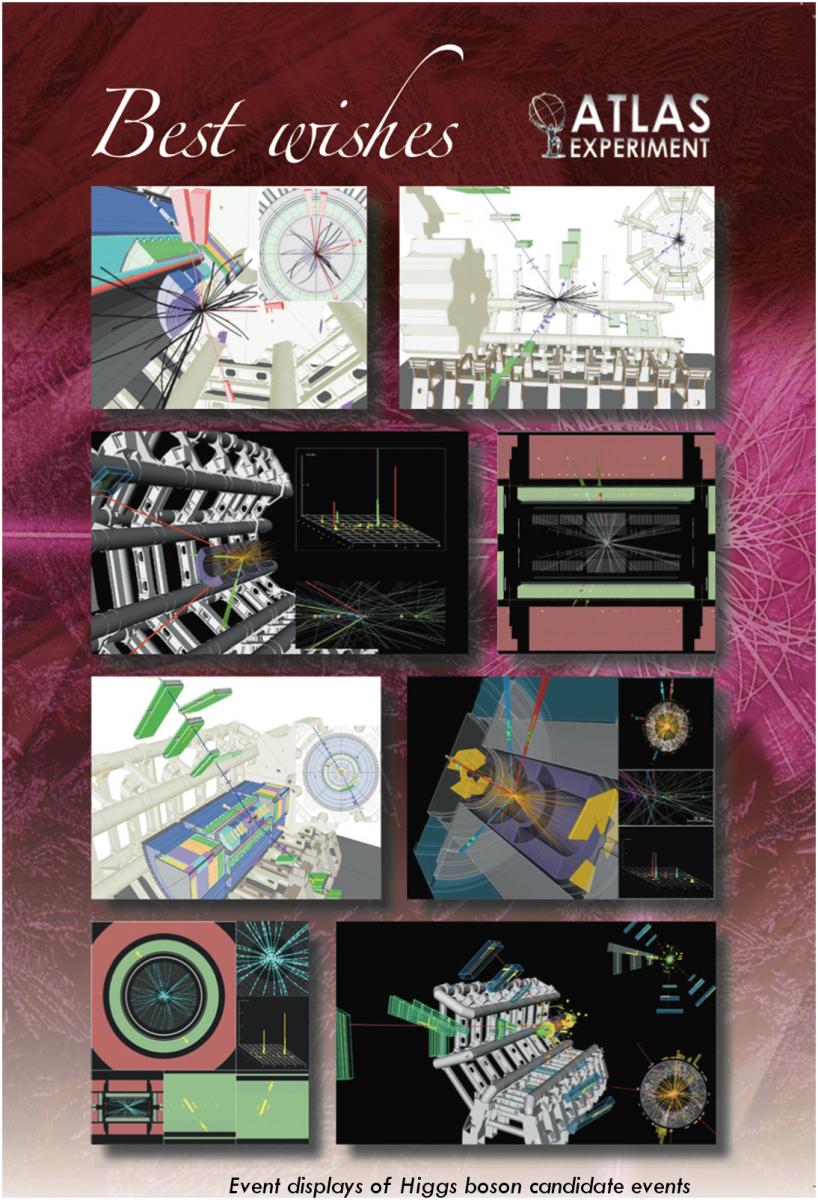2012: A Year for Science – A Year for Discovery
20 December 2012 | By

Amazing, incredible, emotional. These are uncommon words for summarizing the annual accomplishments of a particle physics experiment. Yet 2012 has been a fantastically uncommon year for ATLAS, one of the main experiments at CERN: marvellous machine performance, numerous and interesting physics results, plenty of interactions with students and general public, and - last but not least - a major discovery!
Over the course of the spring and summer, the performance of the LHC shone, as the machine energy was increased to 8 TeV and the luminosity ramped up until the ATLAS and CMS experiments had received hundreds of trillions of proton-proton collisions in their detectors.
On July 4, in a joint seminar, these two experiments unveiled that the data bore sufficient evidence to declare the discovery of a new boson. Peter Higgs, Francois Englert, Gerald Guralnik, and Carl Hagen, present at the seminar, were among those physicists who in 1964 had predicted the existence of an all-pervasive field that gives mass to elementary particles. Discovery of a boson, which is an excitation of the field, would support that theory.
The patience of the theorists (who had originally predicted that the Higgs boson would be too difficult to find) was only matched by the hard work and perseverance of the experimentalists, some of who had dedicated more than 20 years of their lives to the pursuit of the discovery.
Perhaps most notable, however, was the attendance of the public, one billion of whom witnessed the event either live or via world-wide re-broadcasts. Congratulatory notes in the social media were abundant and gratifying: "Congrats to you all at ATLAS. Great job!" "Thank you so very much for your dedication, perseverance and most importantly, your unbelievable success!"
The 3000 physicists from 38 countries that make up ATLAS know very well the importance of fundamental research and the huge impact it has on mankind. It is nevertheless heart-warming to hear that message resonated by the public, on July 4, and in the months that have followed.
And that was just the summer! Since that time, the efficient performance of the LHC and ATLAS has dramatically increased the data set available for exploration. In the pursuit of a better understanding of the Universe, precise measurements were made on the Standard Model and new, important constraints were placed on alternative theoretical models, such as supersymmetry and extra-dimensions. The ATLAS collaboration participated in more than 120 international high energy physics conferences around the world to share its results.
In fundamental research, the pursuit of discovery can be as fruitful as discovery itself, and 2012 was no exception. More than 1000 PhD and Master’s students participated in ATLAS while writing theses on their research. They also contributed significantly to the 127 physics publications and 172 conference notes produced during the year.

In 2012, ATLAS ramped up its efforts to inform the public of its goals and accomplishments, using a variety of communication platforms. Around the globe, collaboration members from the 176 ATLAS institutions were busy hosting public presentations, participating in media interviews, writing blogs, giving class lectures, and even holding science slams at the local pub. Back at CERN, the ATLAS Visitor Centre welcomed more than 40,000 visitors, half of them students and teachers. Thousands who could not make the trip in person were welcomed into the Control Room on ATLAS Virtual Visits, a live video program that received the Digital Communication Award this year for Best Online Event. In the autumn, ATLAS joined forces with others at CERN to launch Hangout with CERN, a series of public video discussions, focused on answering questions about the laboratory and its physics program.
Throughout the year, the ATLAS public web pages, the ATLAS Blog, its social media sites (facebook, Google+, Twitter) received millions of visitors and continue to increase rapidly in popularity. Most importantly, these direct interactions with the public have served both as a means to share the excitement of research and to remind ATLAS physicists of their obligation to humanity.
The coming year will bring dramatic change to ATLAS and the LHC, as operations cease in February, following the heavy ion run, and work begins to upgrade the machine to deliver 6.5 TeV proton beams at even higher luminosity. The detector faces numerous upgrades that will allow it to improve performance and to prepare for the higher energy.
For the public, there will be a large number of visits both above and below ground, continued virtual visits, and a variety of local events, including TEDxCERN in May and a CERN Open Day, scheduled for September 2013. Keep yourself informed about all the CERN and ATLAS activities by subscribing to the ATLAS social media sites and by following the news on the CERN and ATLAS public web pages.
Yes, 2012 was an amazing year for ATLAS and for science; there is no doubt about it. The marvellous thing is that the years to come seem more than promising. With upgraded accelerator and detector, as well as with significantly higher energy in 2015, the ATLAS physicists can’t wait to find out what other surprises Mother Nature is hiding!



